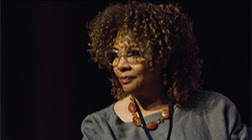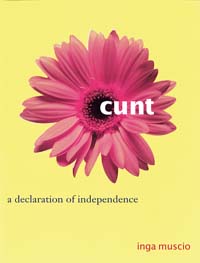
Menstruation, also known as a period or monthly, is the regular discharge of blood and mucosal tissue from the inner lining of the uterus through the vagina. The first period usually begins between twelve and fifteen years of age, a point in time known as menarche. However, periods may occasionally start as young as eight years old and still be considered normal. The average age of the first period is generally later in the developing world, and earlier in the developed world. The typical length of time between the first day of one period and the first day of the next is 21 to 45 days in young women, and 21 to 31 days in adults. Bleeding usually lasts around 2 to 7 days. Menstruation stops occurring after menopause, which usually occurs between 45 and 55 years of age. Periods also stop during pregnancy and typically do not resume during the initial months of breastfeeding.

The menstrual cycle is the regular natural change that occurs in the female reproductive system that makes pregnancy possible. The cycle is required for the production of oocytes, and for the preparation of the uterus for pregnancy. Up to 80% of women report having some symptoms during the one to two weeks prior to menstruation. Common symptoms include acne, tender breasts, bloating, feeling tired, irritability and mood changes. These symptoms interfere with normal life and therefore qualify as premenstrual syndrome in 20 to 30% of women. In 3 to 8%, they are severe.
Menarche is the first menstrual cycle, or first menstrual bleeding, in female humans. From both social and medical perspectives, it is often considered the central event of female puberty, as it signals the possibility of fertility.

Julie Dash is an American film director, writer and producer. Dash received her MFA in 1985 at the UCLA Film School and is one of the graduates and filmmakers born out of a time known as the L.A. Rebellion. After she had written and directed several shorts, her 1991 feature Daughters of the Dust became the first full-length film directed by an African-American woman to obtain general theatrical release in the United States.
"Blues Ain't No Mocking Bird" is a short story by Toni Cade Bambara written in 1971. It is told through the point of view of a young black girl in North America. Blues Ain't No Mockin Bird is about a family whose privacy is invaded by two white cameramen who are making a film for the county's food stamp program. In this story, the little girl is playing with her neighbors, Tyrone and Terry and cousin, Cathy at her grandmother’s house. Her grandmother is on the back porch spreading rum on the cakes she has made. Two white filmmakers, shooting a film ‘‘about food stamps’’ for the county, tree near their yard. The little girl’s grandmother asks them to leave but not listening to her request, they simply move farther away. When Granddaddy Cain returns from hunting a chicken hawk, he takes the camera from the men and smashes it. The white men swears and goes away. Cathy, the distant cousin of the little girl, displays a precocious ability to interpret other people’s actions and words as well as an interest in storytelling and writing. Granny shares a story with the children and Cathy which relates to her feeling about people filming without permission. To her, life is not to be publicized to everyone because they are not as "good" or wealthy as others.

Beloved is a 1987 novel by the American writer Toni Morrison. Set after the American Civil War (1861–65), it is inspired by the story of an African-American slave, Margaret Garner, who escaped slavery in Kentucky late January 1856 by fleeing to Ohio, a free state. Morrison had come across the story "A Visit to the Slave Mother who Killed Her Child" in an 1856 newspaper article published in the American Baptist and reproduced in The Black Book, a miscellaneous compilation of black history and culture that Morrison edited in 1974.

The Bluest Eye, published in 1970, is the first novel written by author Toni Morrison. Morrison is an acclaimed African American novelist, Pulitzer, and Nobel Prize winner whose works are praised for addressing the harsh consequences of racism in the US.

Daughters of the Dust is a 1991 independent film written, directed and produced by Julie Dash and is the first feature film directed by an African-American woman distributed theatrically in the United States. Set in 1902, it tells the story of three generations of Gullah women in the Peazant family on Saint Helena Island as they prepare to migrate to the North on the mainland.

Chhaupadi is a tradition associated with the menstrual taboo, in the western part of Nepal which prohibits Hindu women and girls from participating in normal family activities while menstruating, as they are considered "impure".
"Recitatif" is Toni Morrison's only published short story. It was first published in 1983 in Confirmation: An Anthology of African American Women, an anthology edited by Amiri Baraka and his wife Amina Baraka.

Culture and menstruation is about cultural aspects surrounding how society views menstruation. A "menstrual taboo" is any social taboo concerned with menstruation. In some societies it involves menstruation being perceived as unclean or embarrassing, inhibiting even the mention of menstruation whether in public or in private. Many traditional religions consider menstruation ritually unclean, although anthropologists point out that the concepts 'sacred' and 'unclean' may be intimately connected.

Cunt: A Declaration of Independence is a 1998 feminist book by Inga Muscio that called for a breakdown in the boundaries between women and sexuality. In it, the writer hopes to reverse the negative connotations behind female pejoratives. The books traverses such subjects as menstruation, rape, and competition between women.
The seclusion of girls at puberty has been practised in societies around the world, especially prior to the early 20th century. In such cultures, girls' puberty held more significance than boys' due to menstruation, the girl's potential for giving birth, and widespread ideas of ritual purification related to the sacred power of blood. These societies practised various rites of passage, many of which lost their original forms or completely disappeared with the emergence of modern trends such as industrialization.

The Yanomami people are an indigenous group who live in the Amazon Rainforest along the borders of Venezuela and Brazil. There are estimated to be only approximately 35,000 indigenous people remaining. They are interfluvial Indians who live in small villages along the Mavaca and Orinoco Rivers, with each village consisting of a single shabono, or communal dwelling. Largely uncontacted by the outside world, the Yanomami have been affected by illnesses introduced by gold miners since the 1980s. Anthropological studies have emphasized that the Yanomami are a violent people, and although this can be true, the women of the Yanomami culture generally abstain from violence and warfare. Although males dominate the Yanomami culture, Yanomami women play an important role in sustaining their lifestyle.

The Salt Eaters is a 1980 novel, the first such work by Toni Cade Bambara. The novel is written in an experimental style and is explicitly political in tone, with several of the characters being veterans of the civil rights, feminist, and anti-war movements of the 1960s and 1970s. It is set in the fictional town of Claybourne, Georgia.
In Torah and Rabbinic law, a hefsek taharah is a verification method used in the Orthodox Jewish community by a woman who is in a niddah state to determine that menstruation has ceased.
"The Lesson" is a short story by Toni Cade Bambara (1938–1995). It was first published in 1972.
"Raymond's Run" is a short story by Toni Cade Bambara within the collection Gorilla, My Love.
Sharon Bell Mathis is an American librarian and author who has written books mainly for children and young adults.












